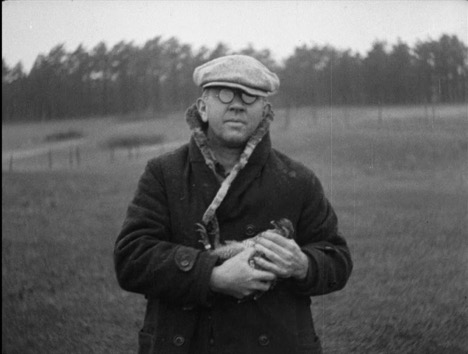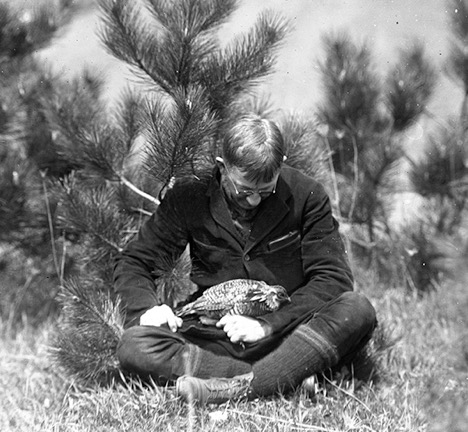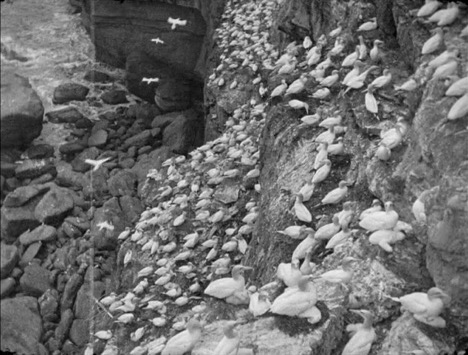Now Showing: ‘The Heath Hen’ and Other Early Ornithological Films of Alfred Otto Gross
By Special Collections and ArchivesRare films documenting ornithological research done in the late 1920s and early 1930s by Bowdoin Professor of Biology Alfred Otto Gross, including previously unknown footage of the last surviving heath hen, have now been preserved, digitized, and published online thanks to support from the National Film Preservation Foundation.
On September 12, 2018, the Bowdoin College Library and Peary-MacMillan Arctic Museum are co-sponsoring the first public screening of the films in nearly ninety years with the program “Rediscovering Historic Films by Alfred Otto Gross, Pioneering Bowdoin Ornithologist: Film Screening and Commentary,” which is open to the public.

The films are a recent gift to the Bowdoin College Library’s George J. Mitchell Department of Special Collections & Archives. They were discovered by Edward Minot in 2015, in his mother’s attic. Minot, the grandson of Alfred Otto Gross, is a biologist and ornithologist like his grandfather, and served as interim director of the Bowdoin Scientific Station on Kent Island in 2017. Recognizing the research and historical value of the films, Minot donated them to Bowdoin College to ensure their long-term preservation and availability to researchers.
The College received funding from the National Film Preservation Foundation in 2017 to preserve two of the most significant films in the collection—The Heath Hen and the Birds of Grenfelland. Both films were produced by Gross in the early 1930s, and were intended to educate a wide audience about the importance of the fragile ecosystems and bird populations he studied. Gross lectured around the country and was nationally known for his pioneering ornithological work. Both specialized and general audiences would have viewed the silent films, which have narrative intertitles that set the stage, describe the main action, and, in some scenes, even introduce a touch of humor to the otherwise serious subjects.
The Heath Hen (14:03 minutes), which was filmed on Martha’s Vineyard, Massachusetts, between 1928 and 1931, opens with scenes of the remaining three males of the species in 1928, followed by footage of Gross and other ornithologists banding the last remaining bird on April 1, 1931. This bird nicknamed “Booming Ben” in reference to the bird’s mating call, disappeared forever in March 1932, and with him the species.
The heath hen’s demise followed a long-period of decline. The bird was widespread on the east coast in colonial days but was hunted into extinction on the mainland by 1870. Despite state sponsored conservation efforts, the sole remaining colony on Martha’s Vineyard, an island four miles off the shore of Cape Cod, suffered a devastating set back in 1916, when a fire destroyed much of the birds’ habitat. Gross was appointed by the State of Massachusetts in 1923 to oversee a long-term project to record and protect the endangered heath hen species, but natural predators, especially the island’s domestic cats, as well as avian disease spread by farm fowls, was too much for the heath hen to overcome.

Gross considered this work “the most interesting and rewarding project” he ever undertook, and his passion and dedication to the heath hen is evident in the film. As narrator, Gross explains that a heath hen he filmed “‘boomed’ a challenge to the rivals who did not come, and for the admiration of the longed for, but absent, mate.” He and his colleagues “wondered if we were viewing the last of his race.”
Until recently, researchers and the public believed the only footage of the heath hen was a film created by the Massachusetts Department of Conservation, Division of Fisheries and Game, in 1926 or 1927. The Gross films, taken closer to the time of the animal’s demise and including scenes of Booming Ben, will be of great interest to the biological community. While the heath hen has been gone for nearly a century, there are considerable lessons to be learned from its demise. It was the first species scientists witnessed firsthand become extinct, and Gross’s films document that moment in faithful clarity.
Gross’s other work, The Birds of Grenfelland (30:41 minutes), was recorded during a 1931 research trip undertaken by Alfred Gross, his son William Gross, and Thornton Burgess, a well-known children’s author and conservationist, to study bird colonies in the coastal regions of the Gulf of Saint Lawrence, Newfoundland, and southern Labrador. Among the locations Gross filmed was the Îles Sainte-Marie Migratory Bird Sanctuary, which was established by the Canadian government in 1925. Expedition members are shown interacting with murres, auks, puffins, cormorants, and double cormorants along this and other rocky shores.

The film’s title references Sir Wilfred Grenfell, a medical missionary in Newfoundland whose work was then internationally known. Grenfell and his ship, the Strathcona II, appear in the film, as do scenes of Inuit in coastal communities. The film also provides a firsthand account of the challenges of the expedition; at one point, the group precariously hoists an early model car onto a dinghy for transport to the shore.
The films are part of a larger archival collection at Bowdoin College documenting the many scientific and ornithological contributions of Alfred Otto Gross, whose career spanned more than forty years and included research in fragile coastal communities in Panama as well as the United States and Canada. He also served as an ornithologist on the Arctic explorer Donald B. MacMillan’s expedition to Labrador in 1934.
Preservation of the films was sponsored by the National Film Preservation Foundation (NFPF), a nonprofit organization created by the US Congress to help save America’s film heritage. The NFPF is the charitable affiliate of the National Film Preservation Board of the Library of Congress. The NFPF preservation grants target newsreels, silent-era films, culturally important home movies, avant-garde films, and endangered independent productions that fall under the radar of commercial preservation programs.
Grant funds allowed Special Collections to outsource the film preservation work to Colorlab in Maryland where the films were inspected, cleaned, and repaired and then scanned at high resolution. Colorlab created new 35mm, polyester, black-and-white, duplicate negatives and prints from these data files, as well as use copies on DVD, which are now available for viewing in the library. The films can also be accessed freely online through the collection guide for the Alfred Otto Gross Papers.
To celebrate the rescue and preservation of the films and to mark their accessibility after nearly 90 years, the Bowdoin College Library and the Peary-MacMillan Arctic Museum are jointly hosting a discussion and film viewing Wednesday, September 12, 2018, at 7 pm in Beam Classroom, Visual Arts Center. Staff from both organizations, as well as Ed Minot, will be on hand to provide background about Alfred Otto Gross and his collection and to contextualize his ornithological work.



